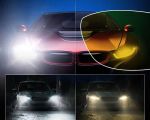- 1-Understanding-Eye-Strain-While-Driving
- 2-Importance-Of-Regular-Eye-Checkups
- 3-Proper-Vehicle-Lighting-And-Visibility
- 4-Effective-Driving-Habits-To-Reduce-Eye-Fatigue
- 5-Benefits-Of-Protective-Eyewear
- 6-Lifestyle-Tips-To-Support-Eye-Health
1. Understanding Eye Strain While Driving
Eye strain during long drives is a common issue affecting many drivers, especially those who spend hours behind the wheel without sufficient breaks. The constant focus required to monitor traffic, road signs, and changing environments demands significant visual effort, which can tire the eyes and reduce alertness.
Symptoms of eye strain include dryness, blurred vision, headaches, and difficulty concentrating—all of which can compromise driving safety. Understanding these symptoms is the first step in learning how to prevent eye strain during long drives. The visual demands of night driving, glare from oncoming headlights, and fluctuating light conditions exacerbate the problem, making eye care essential for any long-distance traveler.
Studies indicate that drivers who experience eye fatigue are more prone to delayed reaction times and accidents. This underscores the importance of addressing eye health proactively, especially for professional drivers and frequent travelers.
2. Importance of Regular Eye Checkups
Regular eye examinations play a crucial role in preventing eye strain during long drives. Comprehensive checkups help identify underlying issues such as refractive errors, dry eye syndrome, or early signs of glaucoma, which may contribute to visual discomfort.
Optometrists can recommend corrective lenses tailored for driving, including anti-reflective coatings that reduce glare and enhance clarity. For example, drivers with mild astigmatism or presbyopia benefit significantly from lenses designed specifically to reduce strain during prolonged focus on the road.
Scheduling annual or biannual visits with eye care professionals ensures that your vision remains optimized, providing the best possible defense against eye fatigue. For trusted eyewear and professional guidance, services like those offered by Eye Docs can be invaluable.
3. Proper Vehicle Lighting and Visibility
Maintaining optimal lighting conditions inside and outside your vehicle is essential for minimizing eye strain. Clean windshields and properly adjusted headlights improve visibility and reduce the effort your eyes expend while driving.
Using polarized sunglasses during daytime can significantly reduce glare from reflective surfaces like wet roads or shiny vehicles. At night, ensure that dashboard lights are dimmed to avoid overwhelming brightness that forces your eyes to constantly adjust.
Modern vehicles often come with adaptive lighting systems that adjust beam intensity based on driving conditions—utilizing these features can ease visual strain. Simple steps like replacing dull or misaligned headlights also contribute to safer, more comfortable driving.
4. Effective Driving Habits to Reduce Eye Fatigue
Adopting smart driving habits can help mitigate the risk of eye strain during long journeys. Taking regular breaks—ideally every 1 to 2 hours—allows your eyes to rest and recover. During these pauses, focus on distant objects to relax the eye muscles, a technique known as the 20-20-20 rule: every 20 minutes, look at something 20 feet away for at least 20 seconds.
Proper seating position and maintaining good posture also influence eye comfort. Adjusting your seat to minimize glare and positioning your head to reduce strain on the neck can enhance overall comfort.
Hydration plays a role as well; drinking water helps maintain tear production, preventing dry eyes. Planning routes to avoid intense sun exposure during peak hours can further reduce visual fatigue.
5. Benefits of Protective Eyewear
Specialized eyewear designed for driving offers targeted solutions for reducing eye strain. Glasses with blue light filtering lenses protect against harmful light emitted from digital displays like GPS devices and dashboard screens.
Anti-glare coatings are particularly beneficial during night driving or in foggy conditions, minimizing reflections that force your eyes to work harder. Some eyewear brands also offer transition lenses that adapt to varying light conditions, reducing the need to switch glasses throughout the day.
Choosing the right eyewear tailored to your needs, with professional fitting and consultation from Eye Docs, can drastically improve your comfort and safety on the road.
6. Lifestyle Tips to Support Eye Health
Maintaining healthy eyes extends beyond the car. Nutrition rich in omega-3 fatty acids, vitamins C and E, and zinc supports eye health. Foods like leafy greens, fish, and nuts nourish the eyes and may reduce the risk of chronic conditions.
Limiting screen time outside of driving and practicing good sleep hygiene also prevent overall eye fatigue. Stress management techniques like mindfulness and regular exercise contribute positively to visual comfort.
Combining these lifestyle habits with proper eye care ensures your eyes stay resilient, enabling safer and more comfortable long drives.
Taking Care of Your Eyes on the Road
Preventing eye strain during long drives is achievable through a combination of awareness, proactive care, and lifestyle adjustments. Regular checkups, proper lighting, protective eyewear, and smart driving habits form a holistic approach to maintaining visual health.
For those seeking expert advice and the best eyewear solutions to support their driving needs, Eye Docs offers a wide range of products and professional services tailored to reduce eye fatigue and enhance clarity on the road.
Prioritize your eye health today to ensure every drive is safe, comfortable, and enjoyable.








